The Heroine with a Thousand Faces
As the youngest member of #TeamPurpleLion, not only have I learned a lot in just the four months we’ve been working together, but I’ve explained a lot of what I’ve learned to others. Sometimes it’s about the history of Defender of the Universe and Beast King GoLion that @crystal-rebellion researched, sometimes it’s referencing @felixazrael‘s musical knowhow or @leakinghate‘s animation knowledge, and most recently, it’s leaning on @voltronisruiningmylife‘s expertise in how to break down and identify writing to provide corrections to those who see something in a show or article not working but can’t tell why. One big thing I learned since starting this crazy ride with my team is a massive hole in my college education on writing, which Felix filled in for me since we hit the ground running. Sure in my fantasy literature class we discussed Aesop and The Hobbit, and what the phrase “The Hero’s Journey” means and why it’s the monomyth, but there was one thing that my dear professor never taught us, although I’m sure she will in the future. Compared to Joseph Campbell’s heroic journey, this other monomyth is much younger.
What is it, you may ask?
Simply put, it’s a heroine’s journey.

[Image description: Princess Allura with her hair up and wearing her flightsuit from season 1 “The Rise of Voltron” backlit by white light.]
Let’s go on an adventure together.
To understand the heroine’s journey, I want to give you all a rundown on what exactly the hero’s journey is first. While it was never neatly labeled as “The Hero’s Journey” until Campbell, studies on common themes and plot points began back in the 1870’s. As time moved forward, Campbell published his 17 steps to the monomyth in 1949 (The Hero with a Thousand Faces) and as we move toward the present his monomyth is eventually dubbed as “the hero’s journey”. I won’t overload you with the dates and stuff I needed to study since that’s a) not the point of this piece and b) Campbell’s monomyth is actually secondary to the main one in Voltron: Legendary Defender. That said, it’s the backbone of a lot of literature both old and new, and while not every story follows these 17 steps outlined by Campbell or approaches them in the same order, you’ll find everything from the story of Christ to Lord of the Rings somewhere in these steps. It’s just that a lot of times the steps of the hero’s journey aren’t ever really explained, so you as a reader/viewer/consumer will see them and will have a gut instinct as to what’s supposed to happen, and when it happens you feel great! The story followed a formula that satisfies its audience! But it also makes a story that doesn’t follow a formula feel fundamentally wrong, from just a mild discomfort like putting on a shirt and buttoning it slightly off, all the way to triggering strong emotional responses including panic attacks or tears. Stories are designed to bring forth emotions from their audience, but what good is a tragedy without a lesson to learn? How can we enjoy an empty marriage when the couple has no chemistry?
So with this piece, I hope to illuminate just what the steps of the heroine’s journey are, contrast them against the hero’s journey, where VLD fits into all of this, and through that demonstrate why they are not interchangeable even though they share similar names.
Part I: Of Heroes and Heroines
In The Hero With a Thousand Faces, Joseph Campbell outlines seventeen steps, which are laid out in this diagram by Reg Harris:

[Image description: diagram of The Hero’s Journey using a circular diagram shape separating out the seventeen steps into eight categories, divided into the Known World and the Unknown World.]
In Maureen Murdock’s The Heroine’s Journey, she writes the heroine’s journey as follows:
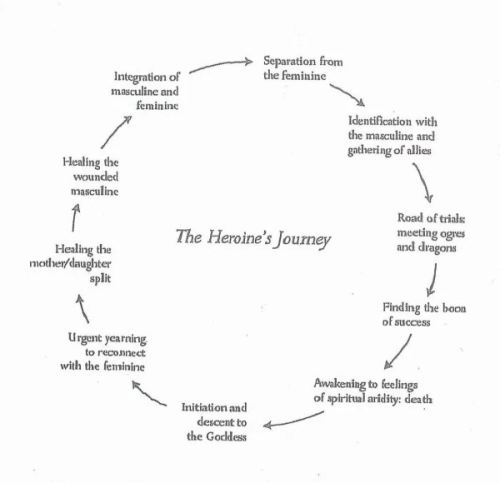
[Image description: The Heroine’s Journey depicting a cyclical diagram of the narrative, featuring 10 distinct steps that loop back to the beginning at the top.]
The Heroine’s Journey is fundamentally cyclical in nature, and while the diagram above shows the Hero’s Journey as a circle as well, it ultimately has finite start and end points. One of the key differences between these is that the Hero’s Journey explores internal character in an external adventure and the hero achieves a (theoretically) lasting peace once their journey is finished. Conversely, the heroine must constantly evaluate themselves in the bigoted environment that tries to disenfranchise them.
As a note, while I use gendered terms such as “hero” and “heroine”, I use them as gender-neutral placeholders to label which monomyth I’m speaking about at present. Women can undertake a hero’s journey, and men can undertake a heroine’s journey, particularly when you examine them in an intersectional lens.
A heroine’s journey, at its heart, is an examination and acceptance of the self in an unaccepting environment, and its cyclical nature stems from the fact that whenever a heroine moves into a new environment, they have to make that journey over and over. They can be a queer man of color, a white stay-at-home mom, a disabled nonbinary person, whatever the case, the constant need to re-evaluate their place in the world is what marks the heroine’s journey as separate from the hero’s journey.
But while it’s cyclical in nature, we should start at the beginning nonetheless.
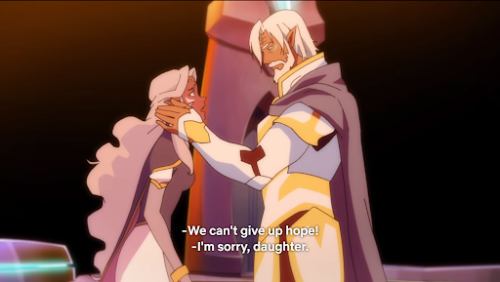
[Image description: Alfor (right) holding Allura (left) in the Castle of Lions. She says, “We can’t give up hope!” and he replies, “I’m sorry, daughter.”]
In The Heroine’s Journey, the story begins when an event causes the heroine to separate from the feminine. A significant event spurs them to reject the prescribed role of the patriarchy, which in the case of a woman could be a mother, a damsel in distress, a wife, etc. The heroine is put into a box and chafes against its edges because it cuts them off from their ability to reach for the masculine, the power and privilege it affords. This marks a stark difference from how our archetypal hero lives and begins their own adventure. The hero lives a fairly mundane life for the brief time we see them before the first element comes into play: the Call to Adventure. This is generally an external force spurring the hero to action, as opposed to the internal force of the heroine.
The hero then will Refuse the Call and will be introduced to the Mentor they will come to rely upon, whereas the heroine typically immediately begins on a journey to become more powerful/masculine, generally through rejecting femininity. Princess Allura does not inherently reject her own femininity. She rejects the helplessness of being forced into cryostasis after her people have been destroyed and embarks on embracing her masculinity by finishing the war her father and Zarkon started 10,000 years ago. The heroine Identifies with the Masculine and Gathers Allies, which we see Allura do in the pilot of season 1 of VLD. She awakens to find a team of five men and her male adviser Coran, her allies in the coming intergalactic war, and she takes up the metaphorical lion herself as the pilot to the Castle of Lions, changing into her armor–pink, to honor the fallen–for the fight against Sendak as he tries to claim the Lions of Voltron for Emperor Zarkon. Her choice of pink, particularly pale pink, is reminiscent of the breast cancer awareness ribbon, baby pink, it is an intrinsically female color that she dons to assume the role of her father, King Alfor. The narrative is reminding the audience that Princess Allura–the first nonwhite Allura, no less–is just as much a princess as her previous white and blonde iterations are warriors.
After choosing their allies and undertaking this quest of gaining power (not to be confused with empowerment, our heroine is still operating within the confines of the patriarchy here), our heroine undergoes trials and faces enemies that try to persuade them back into the box, into what’s known and fundamentally safe and silencing. The words may be kind, be delivered kindly, but ultimately they can be boiled down to a single message: “go back to where you belong.” For the hero this is a point of no return as an external journey. The hero can choose to go home and leave saving the world to someone else, or they can choose to face the trials that bar them from their prize. But the heroine? They can’t. There is nobody who can save the heroine’s world because for them because their world is what they are trying to escape, and often they are the prize for a hero. It’s up to them to save themselves, and at this point in time, adopting the masculine and the power of the father figure is the way to go. And it works. Princess Allura, again while she does not get discouraged by the men around her to remain an idle princess, because this is the 21st goddamn century, her conflict arises from inexperience. King Alfor supports her drive to finish the war and take decisive action, to finish what he started. The Paladins challenge her authority as a sovereign in the beginning because even if she’s a princess by birth, she has no planet and they’re not of her planet or species anyway, and until they themselves undergo trials in the first few episodes do they appreciate that Allura is still critical as a person, despite her lack of sovereign weight.
Together, she and her team move through the obstacles and the war against Zarkon together, while simultaneously trying to build a coalition of allies to aid in the fight. In fact, much of the plot of VLD takes place during this stage of the heroine’s journey, and it’s here where we as the audience follow Allura as she meets her animus in the form of a Shadow figure: the cunning Prince Lotor. He takes on the role of the challenger to force Allura to better herself, and as Allura rises to the occasion each time, he is textually impressed by her battle skill, then by her intellect. The most iconic moment of Lotor as a Shadow (aka: the half of herself that Allura doesn’t want to accept yet), is when he baits Voltron into battle, then pilots his cruiser through the volatile environment of Thayserix. He expresses disappointment at Voltron’s ability in battle, but when Allura in Blue rises to meet the challenge he lays out, he praises her, even if he textually does not realize who is in Blue at the time.
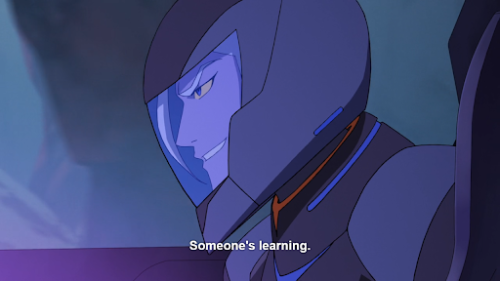
[Image description: Prince Lotor in profile, a pleased expression on his face, and the subtitles read “Someone’s learning.”]
As a brief aside: the animus comes from Jung and is often paired with an anima, or masculine and feminine energies. The key takeaway is that these energies are complementary to each other and exist in a balance. While they typically are portrayed in a more heterosexual context, like everything else in this meta, the terms are used in a gender-neutral context when not applied directly to Allura’s storyline. While Lotor could be likened to either Meeting the Goddess or (Wo)Man as Temptress in the hero’s journey, a key difference between the heroine’s journey animus and either of these feminized roles is that the Goddess and Temptress are two separate figures–generally women to male heroes–and are generally not equal to the hero physically or mentally. The animus, however, is intrinsically the perfect match to the anima of the heroine, being their complement and their intellectual and physical equal. Lotor is not meant to be seen as the woman on Indiana Jones’ arm, he’s meant to be a force in his own right, challenging Allura to better herself and raise the standards for them both. It’s fitting that this occurs in an episode full of fog and a dangerous abyss, because the traditional hero descends into a metaphorical (or literal) one to encounter these flattened versions of feminine energy.
The trials continue for Allura through the seasons, and she makes many allies and continues to face their enemies head-on, and once Prince Lotor, now Emperor, cements his place as one of Allura’s allies he shifts from the Shadow figure challenging her to the animus in full, being encouraging and supportive as they work together as allies to find Oriande, a mythical place that should yield them the secrets of unlimited Quintessence. While Lotor challenges Allura in a traditionally masculine way (physical trials, battle, strategy), he also encourages her in a decidedly feminine way through Altean history and mythology, as Altea is very feminine-coded compared to the Galra Empire, which through Zarkon represents a familiar and violent strain of masculinity that seeks to crush Allura and force the universe to fit his will through abusive language and physical violence and genocide. Allura taking up the battle in Alfor’s place is simply her continuing the cycle and seeing power in masculine terms, rather than breaking the cycle.
Now here is where the diagrams diverge even further. Until this point, the journeys followed fairly similar trajectories. After the trials and battles of the heroine’s journey, they experience the boon of the journey, which the hero does not achieve until they face further trials and temptations. As such, we will continue to follow the heroine’s journey model and I’ll explain the significance of the flip.
Part II: Not the Place to Arrive
One of the significant things about the heroine’s journey is that when a woman undertakes it, it’s empowering and her becoming her most unified self. Campbell once reportedly said to Murdock, “Women don’t need to make the journey. In the whole mythological journey, the woman is there. All she has to do is realize that she’s the place that people are trying to get to.” In the hero’s journey, often a woman’s place is as the prize, rarely is she her own agent. As I stated previously, the hero and heroine journeys do not have to ascribe to gendered protagonists, however the reality is that the hero’s journey is very patriarchal in nature since it was formulated primarily through the study of male heroes and does not take into account the constant reassessment heroines must face. For heroes, they simply must survive going from point A to point B. Heroines are always subjected to reevaluation within their environment and the people around them, so their journey never really ends.
All this is to say that the hero receives their boon at the end of their story and that’s the end of it. They get a happily ever after and can return to normal life and spread their bounty to those in need or dearest to them.
The heroines?
They get their boon at the middle of the story.
And there’s still more to come for our heroine as they build toward the climax (pun intended).
Princess Allura receives the boon of Oriande’s secrets with Lotor by her side, which in pretty much every literature class would become a discussion on the ways this represents sex, or the the ways Allura is interacting with the world in terms of gender, particularly how they discover Oriande after having an emotional reaction in Haggar’s lab and activating the Altean compass stone. In the heroine’s journey, this boon is often of the same significance as the hero’s boon/reward at the end of their journey, but for the heroine it’s false. It’s fleeting. It’s not meant to last. This is the turning point for our heroine because while yes, our heroine achieved the goal of the adventure, they did so by consciously or unconsciously shunning the feminine. In Allura’s case, she’s still taking after her father, trying to follow in his–and to an extent Zarkon’s–footsteps by mastering the unlimited Quintessence.
And true to form, before season 6 is out, our heroine seems to be betrayed by her animus, returning him to the status of Shadow figure as he challenges her to unleash the power within one final time. Princess Allura thinks Lotor lied to her and has been harvesting Alteans for their Quintessence when Keith and his mother Krolia discover a living Altean in the Quantum Abyss, and with the budding on-screen romance between Allura and Lotor, this betrayal cuts our heroine deep. To her, he not only lied about there being no more Alteans left, but he actively continued the genocide his father began 10,000 years ago. That’s not an easy thing to get over. So Lotor assembles Sincline, which bears a visual resemblance to a wingless dragon–the last metaphorical dragon she faces before moving into the next step of the heroine’s journey–and with Allura in Voltron the two battle it out in a tragic action-packed scene that leads to Voltron overloading Lotor with Quintessence and leaving him in the Rift.
With the dragon defeated and the boon lost, the heroine has to sacrifice not only her animus, but the last vestiges of her home to try and undo what following the masculine has done: close not only the original Rift, but all the fractures in reality caused by their battle.
And what does a girl who has already lost her planet, people, and lover have left to lose?
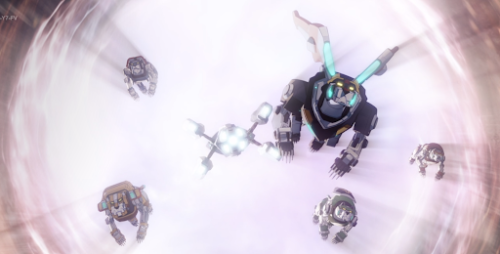
[Image description: The five Lions of Voltron flying away from the massive Rift, the Castle of Lions flying straight toward the center of it.]
The heroine following the footsteps of the masculine always comes at a major cost to them. In Allura’s case, she has to sacrifice her castle in order to make right the harm done to the literal universe. In this case, she mirrors Zarkon in his destruction of the universe, but rather than directly harming billions of lives on uncounted planets, she creates a literal hole in the universe because of her blindness to the consequences of the actions of herself and those around her.
And much like her father sending away the Lions, she must send away her castle in the hopes of saving the universe from greater destruction.
Part III: Transcending the Rift
From the gain and loss of the boon, things look dire for the heroine at this stage in the journey. In Allura’s case, she is without people, without planet, without castle, and as she learns at the beginning of season 8, her found family has families of their own–other than Coran, that is. Our heroine continues to lose pieces of the things and people surrounding her at the beginning of the story: which Murdock refers to as awakening feelings of spiritual aridity or death. She is losing her place in the universe even faster than before, when she stood on the shoulders of her father, and she must move forward. Allura passed the point of no return all the way back in season 1 episode 1. As the heroine, she broke free of the safe mold she knew for the past 10,000 years, and every episode since her awakening she has had to try to forge forward on the path she knew: that of her father. Now, though, her father’s methods have failed her, just as they failed him, leaving her with no option but to keep moving forward and to approach her journey from another angle.
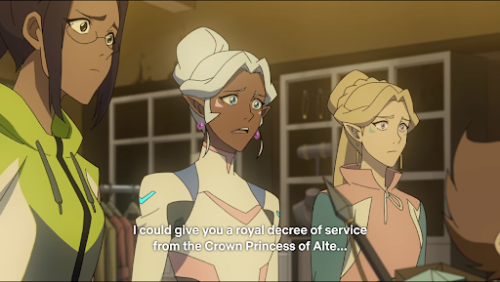
[Image description: from left to right, Veronica, Allura, Romelle, and Pidge (mostly off-screen) in a clothing swap shop as Allura speaks. Caption reads, “I could give you a royal decree of service from the Crown Princess of Alte…”]
Allura not only must deal with the loss of her place in the universe, but she must also deal with the fact that by leaving Lotor in the Rift, she abandons half of herself as well. Physically she is a whole person, but if we look at her role as an anima and what her fears and strengths are, destroying her animus throws her self-knowledge out of alignment. She’s careening away from the safe path of her father, but she must now rediscover the strengths within herself without succumbing to her weaknesses and do so by stepping out of her father’s shadow.
Season 8 is rife with emotional buildup and no payoff. We as the audience don’t know what happened to Lotor for the whole of season 7 and we see Allura struggling to deal with all her losses, we travel to Earth and meet the MFE pilots, a plucky bunch who probably were meant to lay groundwork for a new Vehicle Voltron, and we see that Haggar/Honerva is the final big bad of the whole show, ready to vindicate the son she lost to the Rift, but also 10,000 years ago when he was born and she became the Witch we love to hate. So when we join Allura and the gang on Earth with Luca in the infirmary, and Allura’s final trials begin…
Or they should have.

[Image description: Lance and Allura kissing in rainbow lighting where they are artificially-colored in red, then pink, then blue from top to bottom in front of a fading background of warm yellow at the top to gray at the bottom.]
Instead, we are treated to the final acts of a hero’s journey, but still following our heroine through the steps.
Our heroine wears down to the persistence of Lance, who in a heroic journey would receive a fair princess as his boon, and Allura is trying to find a place to belong. In seasons prior to this, Lance acts like a goofy everyday guy, very much a typical character in many present-day stories that allows the audience to see themselves in him. He fantasizes about wooing the princess, calls himself a ladies’ man, tries to be funny, he’s a pretty typical character that a male audience is more likely to sympathize with, and as such the fantasy is pairing up with the prettiest, smartest, etc. girl in the story. The woman as a boon, the Goddess, and the Temptress are never on equal footing with the male hero, and even in the case of female heroes, the meeting with a god(dess) means that the female hero is worthy of being a consort rather than the equal that a heroine is to the anima/animus. In fact, Campbell reportedly told Murdock, “Women don’t need to make the journey. In the whole mythological journey, the woman is there. All she has to do is realize that she’s the place that people are trying to get to.” In the hero’s journey, if the hero is male and heterosexual, the women will always be the prize, the virginal ideal, or the sexualized damnation, and in all of them, the woman is meant to be receptive to the man (and doesn’t THAT sound like some familiar rhetoric). Never is the woman an agent in the hero’s journey when it fulfills a male fantasy. And it is this very same box that spurs a heroine to begin their heroine’s journey: this breakdown of people to individual parts as determined by a patriarchal society.
While Lance is a hero in his own right, in Allura’s heroine journey, he acts as an ogre that comes dressed as a male ally all the way back in season 1. He’s a Subverted Nice Guy in that he’s constantly trying to woo Allura, but ultimately he’s still reinforcing the same patriarchy that not only plagues Allura in this iteration, but also in previous iterations of the Voltron franchise. The Nice Guy doesn’t challenge the heroine like the animus, but rather encourages them to stay in place or to fit a predetermined mold once more.
Look familiar?
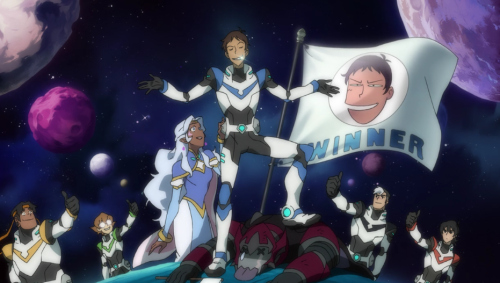
[Image description: Lance’s fantasy, with him standing triumphant over Zarkon as the team cheers him on, Allura kneeling at his right side and looking up at him, while a flag with his face waves on his left.]
Many of the silly shots in the series have been foreshadowing, whether in the most direct sense or in the promise of subverting what’s portrayed. In the case of this screenshot, by the time Lance gets the girl, Zarkon is killed (by Lotor), Allura has already had an intimate relationship (with Lotor), and the team collectively became heroes and allies of Lotor before the end of season 6 happened. Lance, textually, is not Allura’s equal as an animus, and while he doesn’t quite view her as his equal–especially in earlier seasons–he can only textually become her equal when she is at her lowest point, and he’s still affixed to the idea that she’s a prize, going so far as to say that “winning prizes is my specialty” in “Clear Day”. Really, it’s a messy relationship dynamic that tries to show the audience why, as they stand in the canon material, they don’t work. Not only is Allura still not his equal, but his fantasy comes about at the hands of others, or with the help of others, and he comes second. He plays a role, but he is not the singular hero he once fantasized about being. Textually this subversion is teaching him a lesson about becoming his best self and acknowledging that he doesn’t have to be the hero, the payoff of which should have come in season 8 as Allura completes her heroine’s journey to become her most unified and realized self. It’s meant to be his apotheosis, the new perspective and enlightenment brought to the hero after facing all the trials of the journey as a part of the final reward.
Allura, fighting with this sudden loss of herself, must now also help spearhead the war against Honerva, the archetypal Bad Mother, in an alchemist-versus-alchemist battle for not only Lotor’s physical soul but for Allura’s metaphorical one as well. This is a new fight, the gauntlet thrown by someone other than her animus, and after all his tests, she must still rise to the challenge with the same energy, but she must do so with new knowledge now that she knows she cannot rely solely on her father.
But what’s the next step for a heroine trapped in the arid desert of the unknown self and with the weight of the world pressing onto them?
They must descend to the underworld and begin the transformation from the masculine methods to unleash the femininity that’s been locked away this whole time.
And who do we have to escort Allura to the metaphorical underworld as she falls asleep?

[Image description: A close-up of Lotor’s face in deep shadows as he stares head-on at the “camera”.]
Her Animus, acting as a Shadow once more.
His entrance is littered with sex. Not literally, but metaphorically. He greets Allura while she’s in bed, the camera does a gratuitous slow pan over his body in a way that many cameras exclusively afford to women, the presence of a blooming flower with an erect pistil, the lighting of the preview–altered in the final season itself–is purple even, a romantic and spiritual color. You know the joke in college English classes about how everything is sex except sex? That’s this scene in a nutshell. He’s always been drawn and behaved in a way designed to appeal to the female gaze (an essay in itself), but this scene really takes the cake.
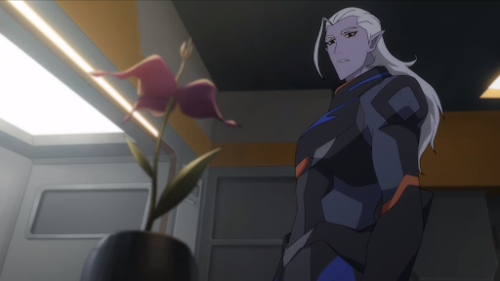
[Image description: Lotor as viewed in profile from a low angle in a Garrison room, looking down at a juniberry flower in a pot.]
And it’s this scene where we see Lotor give Allura the first critical piece of information for how she can stop Honerva/Haggar, but also reminding her that some people do not change. While Allura must change to achieve her realization, he reminds her that Haggar is still the same witch, and that her pain of losing Lotor becoming public does not excuse the fact that she has not expressed remorse or tried to change herself, let alone her hand in not only his downfall but in the brainwashing of the Alteans. She is an antagonist so focused on the wrongs done to her that she justifies the wrongs she does to others with them. Allura, however, expressed remorse and wanted to save Lotor as soon as she realized what was going on, which further cements the ways in which their fates could have been the same or switched had they made slightly different choices. Honerva is 10,000 years too late. Like Lotor mirrors his father and in “Shadows” is shown to be more empathetic, Allura mirrors Honerva and both prove throughout the show to have stronger moral compasses than their predecessors. They are the Emperor and Alchemist, and while fate decrees they must take up the mantle left behind, their free will dictates that they should not blindly follow their footsteps if they truly wish to make a lasting change. Narratively, they must forge a new path if they are to bring the universe to peace again.

[Image description: A close-up shot of the juniberry flower with Allura visible in the background, but blurred. The subtitle reads Lotor’s line, “The witch may change her name, but she will always be a witch.”]
Lotor tempts Allura to take the entity into herself, and when she reaches out to connect with it, she is taken further into the dreamscape and finds herself back on Altea and greeted by her mother. This marks the beginning of the reconnection with the feminine, but while Allura has always so desperately missed her family and Altea, she finds herself in a precarious position. Suddenly, she is in the very same mech suit that Luca was found in, and to save Altea from the Galra fleet overhead, she makes the decision to use the planet’s Quintessence. However, in the process of destroying the Galra fleet, destroys Altea as well. As her world crumbles, her mother congratulates her for a job well done. This presumably mirrors the dropped plot about the Altean Colony and the decisions Lotor would have been faced with, and after “Shadows” would lend both Allura and the audience a greater appreciation for the position he was in before he died.
And when she finally wakes?
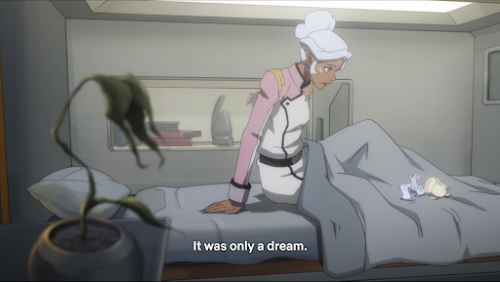
[Image description: Allura sitting up in the Garrison bunk, looking at the mice, the juniberry dry and wilted in the foreground, blurry. The subtitle reads, “It was only a dream.”]
Our oh so sexual symbol is wilted, and Allura wakes up alone.
With the visual deflowering and this new revelation about the kinds of decisions those before her have had to make, Allura can begin reconnecting with the feminine in earnest without falling into the old placements she may have been subjected to at the beginning of the story. This would have continued further with Allura reconnecting with her animus in the missing episode @leakinghate titles “The Descent”, especially fitting as she continues her descent to her feminine roots as a heroine and to reconnect with her lost animus. Reconnecting and reconciling with him–and with the side of herself he represents–is critical to her achieving unity within herself and being able to face Honerva head-on.
Once the heroine has descended to the underworld, begun the reconnection to the feminine, and returned with new knowledge on their relationship to their emotional side and the aspects overshadowed by the masculine, they are ready to begin healing the mother/daughter split. This in essence is the heroine returning to the old knowledge she has cast aside when following the path of the masculine/father, but approaching it with a new understanding and perspective. Think of it as understanding why your parents enforced rules like “don’t run into traffic”. As a kid, the danger may not be obvious, but as an adult you’re able to look at the same situation, see over obstacles younger you might not have, and realize “oh shit, that’s a car”. That said, the heroine does not allow themselves to get put back into the same or even a different pre-prescribed role because they now have a greater understanding of the situation at hand.
In Allura’s case, this means revisiting the plan on how to take down Honerva, and realizing that she must pursue the course laid out by her trip to the underworld to not only save the universe, but awaken Lotor from being a robeast. Part of the conflict against this plan comes from the team, who see the entity she took within herself as dangerous. While that’s true, stopping the plan also prevents Allura from growing in strength to be able to fight Honerva. The power flowing within her that Lotor referred to back in season 6 is at her fingertips, and like his visit in “Clear Day” reminded her, she need only take it. During both parts of the “Knights of Light” episodes, Allura is confronted with shades of Honerva’s memories as they dive deeper, and it’s here that we as the audience and the cast are meant to learn what truly became of Lotor after he was imprisoned in the Rift, and it’s meant to be utterly jarring to everyone. Instead, with how the scenes were edited together during the post-production alterations, Hate aptly points out in “Seek Truth in Darkness” that Honerva promising vengeance and seeing Lotor’s corpse has next to no impact. Or rather, it does to the audience–a melted corpse isn’t exactly Y-7 appropriate–but the characters don’t really react to this revelation at all.
That said, it’s more than likely that Allura genuinely believes Lotor to be dead (as opposed to a sleeping prince), which would explain her aggressive reaction to seeing pre-Rift Zarkon, and we don’t see his reaction to learning what he did to his son, either. This would be a prime location for Zarkon to experience and express remorse for what his actions have done to his son, subverting the toxic masculinity narrative his character had been representing prior.
At the end of “Knights of Light Part 2”, Hate mentions that Allura would need to make another trip to the underworld to commune with Lotor and realize that no, he’s not dead, but also that she not only must defeat Honerva, she must do so in order to save Lotor and free everyone of the cycle of violence that began 10,000 years ago. This is the final descent she makes before she can heal the wounded masculine, both in herself, and Lotor directly.

[Image description: Allura in profile inside the cockpit of Blue Lion, unconscious. Her window displays measurement increments and stars in red-tones, while Allura herself is lit in blue tones.]
After the end of this episode, however, Hate mentions that much of what was there is butchered in the post-production editing, so I will be extrapolating based on the content we have in the season as well as utilizing her analysis of the story as it should have been.
When Allura wakes up from falling unconscious, this is when we should see her proposing to save her animus, and it should come with a discussion with Lance about how they don’t click romantically. That said, in the version on Netflix, we see their relationship continue, however much of their shared body language doesn’t necessarily even match up with an awkward couple. Lance seems sullen and possessive, and while he might still be sullen in Allura’s original heroine’s journey, he would have had this moment of growth in which he learns to let go of Allura. She’s his fantasy, and not only is that unfair to Allura, it’s also unfair to him, and he doesn’t need to be the hero or the guy that gets the girl. He can be himself, silly, sharpshooting, video game-playing Lance. A genuinely nice dude, which completes the subversion of the Nice Guy trope his character embodied for so long.
“Uncharted Regions” is a hot mess of an episode in terms of narrative flow and consistency, but this would have marked the beginning of the alchemist vs. alchemist fight for not only Lotor’s soul, but the universe. Honerva uses the Sincline mech and her new mech to start tearing holes through realities, and once Allura jumps into the fray, that moves the audience into the next missing episode proposed by Hate: “Storming the Pyramid”. This would be where Honerva uses Allura to revive Lotor because she did not receive the life-givers’ blessing, and Allura would do it, literally healing the wounded masculine, but also falling right into Honerva’s trap in the process. This would almost certainly be a highly-controversial thing among Allura’s allies, but like Allura remaining on the path she knew, it’s easier to accept Lotor as pure evil who got what he deserved, when at no point is there a definite case against him. In fact, “Shadows” is designed to render him as a sympathetic character, and seeing his melted corpse is even more horrifying after seeing him as a baby and child. But that’s the way it is when a heroine breaks the mold. The heroine defines their own role, and as part of that, it gives them the ability to help others break theirs. The heroine experiences true empowerment by divorcing themselves from the power structures that defined them before, and doing so with the greater knowledge of their internal masculinity and femininity. Allura revisiting the war of her father with the lifegivers’ knowledge to compound her intrinsic alchemical abilities is the moment when she achieves union within herself, and it manifests physically as reviving Lotor, her animus.
It’s after this point that we see the Purple Lion and Purple Paladin manifest, our namesake.
In “Day 47”, Kolivan references the team sizes the Blades of Marmora use. He references four and five as the usual sizes, but six occasionally happening, but what he says next is particularly interesting.

[Image description: Kolivan being filmed for an interview, saying, “Seven seems rare, but… it could happen.”]
The Voltron team had four Paladins briefly after Shiro disappeared and before Allura took up the mantle, but the full team always has five. After Shiro returned for good, their team became six Paladins.
Now, with the healed animus Lotor on their side, they could have the rare seven-person configuration that Hate discusses at length in “Seek Truth in Darkness”.
With the anima and animus aligned together at last with no secrets, they can unify externally the same way Allura unified internally, and battle against Honerva properly. Now, Team V, Lotor, and the entire universe can face Honerva head-on and stand a chance at winning.
We also should get the emotional payoff for Lotor as an abuse victim in his own arc, closing up this nice little loose end that hurts way more than it did before season 8 dropped.

[Image description: An up-close shot of Lotor glaring into the “camera” in green lighting and saying to Haggar, “maybe I will take pity on you when the time comes.”]
And it’s worth mentioning that while the final battle is exciting and action-packed, the final surrender of Honerva comes quietly, in the rift of all realities. The characters of Team V are able to deliver their character-based arc lessons, it’s a somber moment of learning as Allura, using once more the blessing of the lifegivers, enlightens Honerva to her memories and what she’s done, but also restoring her sense of self the way Allura was. This is the final healing of the mother/daughter split, and it’s significant that Honerva’s abuse victim not be her healer. Not only does Lotor (as far as we know) lack the ability, but it’s never the victim’s job to heal their abuser, just as it’s not the obligation of the oppressed to appease their oppressor. Honerva can finally move on and begin atoning for what she did by setting the ghosts of the Paladins of old in her mind free, but that still begs the question of what our heroine and her animus must do to finish the job.
This is where Lotor would get his second chance, in the most literal sense of the term, where he faces a similar trial to the one in Oriande back in season 6 and the burning question for a man so concerned with survival and cunning.
Is there something he would give up the life he has known and fought so hard to keep for?
And this time, the answer is yes.
Allura.
It was always Allura.
While Honerva is able to stop the rift from expanding by, well, not expanding it herself, she lacks the ability to properly close it the way that it was closed the first time. It takes one final adventure, one final unification by the anima and animus, by the heroine and her Shadow, and one final goodbye. Allura and Lotor, born of an age long past, become the lifegivers eternal through staying behind to close the rift.
The lionhearted goddess of life and her stalwart champion of survival.
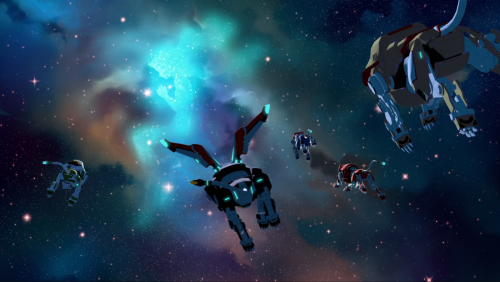
[Image description: The final scene after the credits, where an Allura-shaped nebula is nestled up against a smudged, darker nebula with a sea of stars among them, and the five Lions of Voltron flying toward the nebulae.]
Sources
Dos Santos, Joaquim and Montgomery, Lauren. Voltron: Legendary Defender. Netflix. 2016-2018.
LeakingHate. “Seek Truth in Darkness”. VLD Visuals Detective and Imperial ApologistTM. 2 Mar. 2019. https://leakinghate.tumblr.com/post/183160042843/seek-truth-in-darkness
“Maureen Murdock’s Heroine’s Journey Arc”. The Heroine Journeys Project. https://heroinejourneys.com/heroines-journey/
Murdock, Maureen. The Heroine’s Journey. 1990.
University of Kansas. “Science Fiction Writers Workshop: Joseph Campbell’s Hero’s Journey”. KU Guinn Center for the Study of Science Fiction. http://www.sfcenter.ku.edu/Workshop-stuff/Joseph-Campbell-Hero-Journey.htm
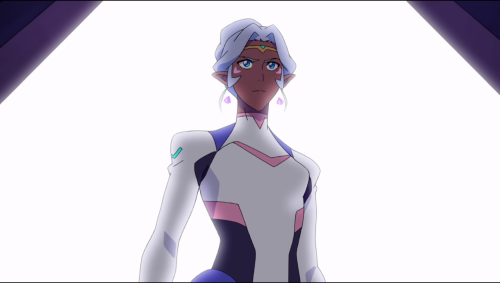
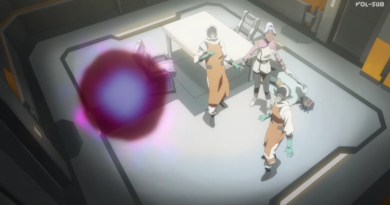
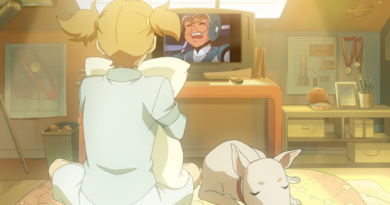
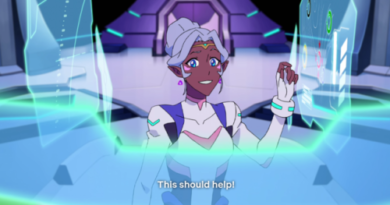
Okay I just had a horrifying thought while reading Murdock’s “The Heroine’s Journey” because my brain is Terrible (and I apologize in advance if this sounds really incriminating towards Lance’s writing/development and this comment’s length)
All the earlier comparisons Allura made of Lance to Alfor (which ring hollow to me since, imo, Alfor had a willingness to let Zarkon lead by acknowledging their respective strengths [“I’m a better alchemist than military leader, Zarkon. I’ll stick with being your right hand.” 3.06], whereas Lance resigned himself to Keith leading after the Black Lion didn’t validate his “moment” [“Okay, you can do it. This is your moment.” “Not only am I not meant to be the leader, I guess… I guess now I’m not even meant to be a paladin.” 3.02])…now discomfort me even more because…what if that’s one of the reasons Allura sought out Lance after her break up with Lotor, the loss of her castle, and being isolated physically and emotionally on Earth and from the surviving Alteans?????
She used Lance to fill the void from missing her comforts and markers of her Altean identity with the man who she weirdly kept comparing to her father “Lance, when you accepted Keith as the new leader of Voltron, it proved that you value a strong team over your own need for glory. Just like my father.” (3.02)
The above comparison ring hollow for me because Alfor was proactive and coming from a place of self assurance. Lance is not at that point in his story, and really, what we see aired doesn’t demonstrate that he ever reaches that point with his arc. He does not learn to genuinely see his own worth and contributions to the team, but hides behind a goofy bravado. Moreover, it seems counterintuitive to me to compare Lance to another respected individual such as Alfor (see his one-sidedly perpetuated conflict with Keith and Lotor bred from envy), when the goal is for Lance to see his own merit where it doesn’t require him to be the leader/hero to love himself or be loved by others
ANE TO EVEN FURTHER THE GRAVE I HAVE MADE HERE, Lance trying to be all “it’s dangerous” to Veronica really…echoes the sentiments he kept badgering on Allura during the entity arc (“You didn’t need to come along on this mission.”
“What are you talking about? I’ve been going on these missions for months now. No one knows the terrain better than me.”
“Yeah, I just don’t like to see you put yourself in danger.”
“First of all, that’s very sweet, but knock it off. You’re an idiot if you think I’m not going to defend our home.” 7.10)
(“I don’t like the idea of using Allura like this. We’re messing with powers we don’t fully understand that have ruined countless lives. It’s… it’s dangerous.” […]
“This is too dangerous. Honerva is gonna use the connection to find us, to find you.”
“No, this is how we are going to find her. But first, I must learn how to utilize this energy to do so.” 8.10)
(“Allura, please. What we just saw, it was all because of the entity. The same one that’s inside you. You need to get rid of it.” 8.11)
Lance comes off as patronizing with his concern over each respective woman’s well being, despite the women being more equipped and knowledgeable to handle their missions. His lesson is about positively recognizing different strengths for optimal results, starting with his own. Alfor also shows this unsolicited overprotective nature over Allura, (“You hold a dark entity within you. Don’t you know how dangerous that is? That’s what led to Honerva and Zarkon’s end.”
“I know the danger. But now I have the power to stop Honerva. You had to make a difficult choice in war by sending the Lions away. I also had to make a difficult choice. I’m not going to be afraid to use the power I have.” 8.10) despite his AI back in 1.01 says this to her: “No, daughter, you were right. I made a terrible mistake, one that cost the universe countless lives. Forming Voltron is the only way to stop Zarkon. You must be willing to sacrifice everything to assemble the lions and correct my error.”
Whoo, this got long and I’m not even sure what my objective was to share this, but these were some observations that struck me as I was reading “The Heroine’s Journey”… which, thank you, Team Purple Lion, for leading me to it! It’s really eye opening, and makes me that much more determined to see the VLD staff’s true vision of Season 8! Thank you for the inspiration and thank you for all the research and evidence you’ve compiled over the months.
I’ll leave this long-winded post on a hopeful note that I believe is just as illuminating as the starry silhouette of Allura and Lotor chased by the lions: “King Alfor connected the lions to Allura’s life force. She alone is the key to the lions’ whereabouts.”
Pingback: For New Readers | Team Purple Lion